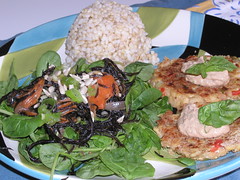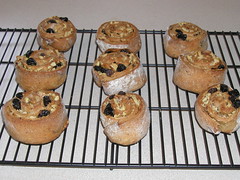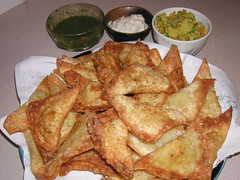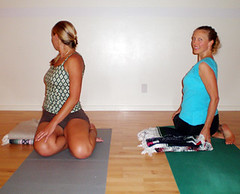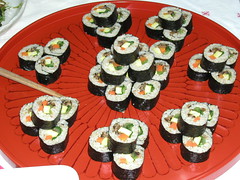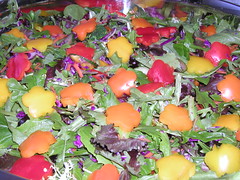Friday, December 07, 2007
Verne Varona’s Top Ten Sugar Craving Strategies
1. REDUCE SALT & PRODUCTS WITH SALT The need for dietary salt from natural sources (sun-dried sea salt) is dependent on several factors; a lack of salt can cause fatigue, stimulate a desire to overeat and often result in a craving or animal protein. However, with the availability of good quality sea salt, miso paste, tamari soy sauce and natural pickles, it's quite easy to overdose. Thirst and a craving for sweet foods is one of the most reliable indicators of excess dietary salt.
2. REDUCE ANIMAL PROTEINThe standard four basic food group propaganda was force-fed to the American public along with the myth that animal protein should be a dietary staple. The meat and potatoes mentality has to re-think its philosophy since established research shows excess animal protein can lead to colon and prostate cancer. If this applies to you eat less in volume (2 to 4 ounce servings) and limit it to three to four times per week (maximum), as opposed to daily.
3. REDUCE FOOD VOLUME Overeating leads to fatigue and sluggishness. This makes a stimulant like sugar (or coffee) more appealing. Eating more frequently will allow you to reduce overeating with a minimum of effort.
4. EAT MORE FREQUENTLY THROUGHOUT THE DAY One of the most common reasons for sugar cravings--especially at night. By skipping meals or waiting long periods you stop supplying your blood with glucose. The blood sugar drops and by the time you finally get around to eating, you're going nuts for simple sugar. You're also likely to end up overeating or craving something fatty as a compensation for sugar. Initially, don't wait more than 31/2 to 4 hours between meals.
5. AVOID EATING PRIOR TO BED If your body's digesting when it requires much needed rest, you'll require more sleep, dream excessively and find it difficult awakening with alertness. Good deep sleep will result in wide-awake days. Eating to close to bedtime creates a groggy awakening craving the stimulation of sugar (or caffeine) the following morning. Eat a light evening dinner at least 21/2 to three hours before retiring.
6. AVOID SUGAR This might sound obvious, however, continuing to eat simple sugars results in a falling blood sugar. This stimulates a need for more sugar and the cycle continues. Even though fruit is a simple sugar, switching to fruit instead of sugar is a good first step. Eat the skin of the fruit as well since fiber slows blood sugar elevation.
7. EXERCISE MODERATELY, BUT CONSISTENTLY Daily aerobic exercise will increase circulation and strengthen will power. Brisk walking, biking, light jogging, etc. naturally increases sensitivity to the effects of sugar. Try to get 20 to 30 minutes of some type of pleasurable exercise at least 5 times per week. Enjoy this. It should not be a chore.
8. EMPHASIZE NATURAL WHOLE COMPLEX-CARBOHYDRATES If your daily diet is includes whole grains (brown rice, oats, millet, barley, etc.), vegetables (roots, greens and round vegetables such as squashes, cabbages, etc.) as a primary fuel, you'll find you automatically crave less sugar. Emphasizing sweet vegetables such as carrots, cooked onions, corn, cabbage, parsnips, squashes, etc., adds a natural sweetness to meals. Introduce some sea vegetables (aka "seaweeds") for much needed minerals to enrich blood.
9. DON'T SUPPRESS FEELINGS This doesn't mean you have to broadcast every feeling--only those that matter and to those who really matter to you. Food indulgence, especially with sweets, is a convenient way to anesthetize feelings. Sugar can consume you with sensory pleasure, temporarily providing mental relief from whatever might be stressful. However, sweets can hinder energy levels and mental clarity so in the long run your emotional coping ability becomes compromised.
10. BEWARE OF PSYCHOLOGICAL TRIGGERS The many psychological associations we connect with food have a powerful influence. Beware of family associations, movie rituals, familiar restaurants, childhood habits, etc.
Naturally Sweet Holidays
Nutty Caramelcorn (Macrojacks)
8 cups organic popped corn (around 1/2 cup before popping)
¼ cup almonds, chopped
¼ cup walnuts, chopped
¼ cup peanuts
¼ cup raisins
½ to 2/3 cup brown rice syrup
Olive oil (to oil the baking pan and pop the corn)
Preheat oven to 350 degrees. Place all ingredients into a large bowl and mix well until the rice syrup covers everything nicely. If the rice syrup is too sticky, heat it up first or it will crush the popcorn as you are trying to mix the ingredients. Transfer mixture to a lightly oiled baking sheet and spread out in a single layer. Bake for 8 to 10 minutes, and watch carefully so that it does not burn. Let cool to harden, about 5 minutes, before removing with a spatula. Soak baking sheet in hot water to remove the hardened sweetener, about 5 minutes.
Utensils: pan to pop corn, baking sheet, wooden spoon, measuring cups
Variations: Substitute puffed or flaked cereals, or crumbled rice cakes for part of the popcorn.
Tuesday, October 09, 2007
Improving Allergies with a Macrobiotic Diet
When a person becomes ill, it means some imbalance can be found in the body. Our bodies can only stand so much before they break down. When we eat things that are unsuitable for us, the body reacts with sneezes, coughing, hives, mucus, diarrhea, vomiting, skin eruptions and anaphylactic shock in its effort to dispel toxins. The more toxins built up, the stronger the reaction will be.
The good news is that balance can be restored by changing one’s diet.
An excessive intake of the following items can increase a person’s susceptibility to allergies:
- dairy products
- oily and greasy foods
- poultry and eggs (especially for skin allergies)
- refined flour
- fruits and their juices (especially tropical fruits)
- sugar, honey, soft drinks
- fish (especially blue-skin fish for skin allergies)
- raw foods
- spices
- drugs and chemicals
Here are several suggestions for allergies:
- Minimize oatmeal, flakes, and grits. Avoid baked flour products, especially those with yeast. If you crave bread, have some natural sourdough or unleavened bread on occasion. Stay away from pies, cakes, and pastries for now.
- Have miso soup or miso rice every day.
- Avoid raw foods in the beginning except good quality natural pickles.
- Minimize intake of oil, using it only for lightly sautéed vegetables once or twice a week, if you really desire it. Use dark sesame oil.
- Initially reduce your intake of beans and bean products, using smaller portions of the “regular use” beans (azuki, lentil, and chickpeas) only. Among bean products, tofu is the best to use.
- Be especially light on all salt seasonings including shoyu, miso, and umeboshi.
- Generally avoid nuts and nut or seed butters. Roasted seeds are alright to use.
- It’s best to stay away from fruit initially. If you crave it, eat a little bit of cooked, temperate climate, dried fruit. If you crave a sweet taste, first try satisfying it by eating naturally sweet vegetables such as squash, carrots, parsnips, rutabaga, etc. You can prepare delicious desserts using grain-based sweeteners, chestnuts, and other non-fruit ingredients. Then, if you still crave an even sweeter taste, eat the fruit.
- Minimize animal food, take only white meat fish, once or twice a week at the most and only if you truly desire it.
- Avoid spices (including mustard, pepper, and curry).
- Make sure to include both lightly cooked foods and well-cooked foods daily.
- Good digestion is very important, so it is imperative to chew very well.
- Pay particular attention to vigorously scrubbing your body with a hot damp towel once a day for good circulation.
Monday, September 17, 2007
tempeh crab cakes
cinnamon rolls
Thursday, September 13, 2007
Trying some fermentation
Tuesday, September 11, 2007
plum perfect
Saturday, August 25, 2007
Butterflies on the echinacea
Flowers at the KI
Lunch at the KI
Tuesday, July 31, 2007
Breakfast with Sanae
Monday, July 30, 2007
Greetings from the Kushi Institute
Tonight's dinner was marinated tempeh with carrot sauce, hijiki with sauteed onions, greens, two types of homemade daikon pickles, and a brown rice salad with vegetables. It was so satisying.
I'll be off to set up for the conference on Tuesday and to check out the Boston area. Hopefully I can post pictures of some things soon.
Monday, July 23, 2007
Tuesday, July 17, 2007
Bharadvajasana 1
(Pose Dedicated to a Sage) » This sitting twist relieves lower back pain and increases the spine's suppleness. Regular practice helps tone the kidneys and increases the range of movement in the shoulders. Here, we present the first stage of the pose. People who are unable to sit on the floor can do the chair twists we have shown in earlier exercises.
1. Sit on the floor with the legs straight (dandasana).
2. Fold your legs to the left with the front of your left ankle resting in the arch of the right foot.
3. Keep your knees close to each other and sit the left buttock on the right heel. If your pelvis tilts down to the right, raise the right buttock on a folded blanket or two. The pelvis should be level.
4. Keeping your buttocks down, lift your trunk as you inhale, then exhale and turn to the right. Hold your right knee with your left hand and take the right hand onto the floor behind your left buttock.
5. Use your arms to help you turn your trunk to the right. Use the breath. As you inhale, lift your trunk, exhale and turn. Keep your chest open and your shoulder blades down and into the back. Gaze over your right shoulder. Stay for up to a minute then return to the center. Straighten your legs and repeat to the other side, reversing the directions.
Ray Madigan and Shelley Choy are certified Iyengar Yoga teachers and co-direct the Manoa Yoga Center at Manoa Marketplace. Visit www.manoayoga.com or call 382-3910. Manoa Yoga Center, the authors, and the Star-Bulletin take no responsibility for any injury arising from the practice of these yoga postures. Readers should seek a doctor's approval before commencing this yoga practice.
starbulletin.com/2007/07/15/features/yoga.html
Thursday, July 12, 2007
Fertility and Diet
A new study found low-fat dairy product consumption is linked to an increased risk of infertility. A total of 18,555 premenopausal women from the Nurses’ Health Study II who attempted a
pregnancy or became pregnant between 1991 and 1999 were evaluated for the association between dairy products and infertility. Women who consumed two or more servings per day of low-fat dairy products had 1.85 times the risk for infertility. While total dairy product intake
was not associated with an increased risk of infertility, the majority of fat in dairy products is saturated fat, which is linked to increased cholesterol, insulin resistance, overweight and obesity, and other health problems.
Chavarro JE, Rich-Edwards JW, Rosner B, Willet WC. A prospective study of dairy foods intake and anovulatory infertility. Hum Reprod. 2007;22(5):1340-1347.
Meat-Eating Moms Have Less-Fertile Sons
A new study in Human Reproduction finds that a pregnant woman’s meat consumption can reduce her future son’s sperm count. Researchers at the University of Rochester in New York analyzed the relationship between various sperm parameters of 387 men and the eating
habits of their mothers from the Study for Future Families. The more beef a mother consumed, the lower her son’s sperm concentration. Sperm count was 24 percent higher in men whose mothers consumed less beef. The difference may be due to steroid hormones found in animal products. Six hormones are commonly used in the United States to induce increased growth and development in cows, and measurable levels are routinely present in the animals’ muscle,
fat, liver, kidneys, and other organs. Cattle raised without extra hormones still have significant hormone levels in their tissues because of endogenous hormone production, and the nutrient profile of animal products tends to elevate hormone levels in the human body.
Swan SH, Liu F, Overstreet JW, Brazil C, Skakkebaek NE. Semen quality of fertile US males in relation to their mothers’ beef consumption during pregnancy. Hum Reprod. Advance access published on March 28, 2007
Friday, July 06, 2007
Benefits of Sea Vegetables
Thursday, July 05, 2007
yoga weekend
Tuesday, July 03, 2007
Tuesday, June 05, 2007
The baby making grain
While teaching a cooking class about health and vitality about a year ago, this woman told me a GREAT story about her father who was in his 70's at the time this happened. They are Chilean, and the father was coming into the US. He had just fathered a baby and was trying to bring the baby with him into the US, but Customs denied permission saying he couldn't possibly be the father due to his age. He told them, "I am not like Americans. I do not eat hamburgers. I'm from CHILE. We eat QUINOA!"
Monday, June 04, 2007
The Four Directions
My expression of gratitude goes out to SM at Rainbow Healing Hawaii for a reminder about the Great Spirit. The practice below is something that I will enjoy incorporating more of in my life.
When a Native American prays to the four directions, it is a prayer to the spirits of the world, to life and the Great Spirit that encompasses the four directions and everything that is. The Medicine Wheel is a symbol that incorporates the four directions. Its spokes point east, south, west, and north. The four quarters are colored red, yellow, black, and white representing the races of man, the seasons, and the stages of life from childhood to old age. The circle is the earth, the moon and the planets. It is the circle of life and all creation.
The simplicity of the symbol is profound. It is four directions. One could divide the world into 8 points of a compass, 360 degrees, or an infinite number of directions, but four is perfect. We humans KNOW four directions. We see forward, but not back, and facing forward we have two sides. Four directions are part of our biology and our psychology. They are archetypes of the highest order. As such they are powerful carriers of symbolic meaning.
Native American traditions may vary somewhat in the terms they use to describe the meaning of the four directions, but the sources of the meaning are the same.
East is where the sun rises. The eastern spirit of sun or fire brings warmth and light. It is the place of beginnings. Its light brings wisdom. It is the power of knowledge.
South is the sun at its highest point. It is the direction from where warm winds blow. South is the spirit of earth, the power of life. It represents peace and renewal.
West is the spirit of water. It is the direction from which darkness comes. It is the power of change, the place of dreams, introspection and the unknown. The west signifies purity and strength.
North is the spirit of wind. The cold wind blows from the north. It is the power of wisdom. Here we take time to reflect on what we began in the east, in the morning, in our youth.
Practice:
Take time to make the world your sacred place. Stand in the middle of the circle of life and give thanks to the four directions. Take your time and attune to the spirit and power of each direction. Look at the gifts each direction gives you. Learn and appreciate the symbols for each direction, but then move out of the abstraction of the symbols and make it personal. Deepen your relationship with the four directions and with the whole of life they form together.Face east and give thanks for the warmth of the sun and the coming new day. Pray for the power of knowledge.
Face south and give thanks for the gift of life on this moist earth. Pray for the power to grow. Pray for peace in the world.
Face west and give thanks for the water of life. Pray for purity and strength. Pray for self understanding.
Face north and give thanks for the great white cleansing wind. Pray for the wisdom of experience.
from http://www.interluderetreat.com/meditate/4direct.htm
The Seven Types of Chewing
1. Basic Situation in the home, office, restaurant, in conversation = 25-50 chews per mouthful
2. Party in a restaurant, club, stadium, with loud noise = 0 to 60
3. Travel in a plane, car, train with conversation going on around or high decibel noise = 25-50
4. Medicinal at home, in a medical center, or other where it's silent or semi-conversational = 50-100
5. Ecological in a natural setting, especially with other socially aware people eating plant-quality foods = 50-100
6. Spiritual where you are alone or with others; silent or semi-conversational = 100 to 300+
7. Free in any and all situations and noise levels = less than 25 to a thousand or more
Sunday, February 04, 2007
Friday, January 12, 2007
Maximize Daily Bliss
Plan 5 things you can do everyday for another person. Let someone merge in front of you a the freeway, for example.
2. Cultivate gratitude.
a)Think about 3 things that went well today and why.
b) Write a thank you letterto the people who have made a difference in your life
3. See your life in 10 years as being the best possible life you can imagine.
4. Maintain strong relationships with others
Find things that you appreciate about others, even when they might make you frustrated
5. See the good side of life
There are always at least two ways to see a situation. When you start to feel angry, frustrated, impatient, etc., try to find something good out of whatever is going on.
Monday, January 08, 2007
Effects of extreme foods on the body
Hard body, inflexible, clog blood vessels, and inhibit body functions. Skin looks tired, pores get blocked, and we look dull, can’t take in moisture, or release toxins. Get dry, dead cells, scaly shins, heels, elbows, lines between the brows, dark circles under the eyes, tight, dry skin, oily skin.
Sugar including maple syrup, high fructose corn syrup, fructose, sucrose, molasses, honey, organic cane juice, turbinado, brown sugar, white sugar, white flour, white rice, potatoes (think of candies, chocolates, soft drinks, snack foods, bread, pasta, cereal, salad dressing, sauces, and other processed foods)
Highs and lows in blood sugar, affecting energy levels and moods. Stresses adrenal glands, and over time, wears us down. It steals essential minerals from bones, teeth, and skin. Causes skin discoloration (red, broken capillaries, freckles, age spots). We get puffy and weak, overweight and lethargic.
Salt including processed, refined, in potato chips, popcorn, nuts, processed foods and meats.
When using sodium chloride, or natural, unprocessed, sun dried sea salt, traditionally processed miso, or tamari in small amounts it is beneficial to the body. However, the other types cause tightening and constriction, inhibiting blood flow to the organs. We grow stiff and hard. Our skin dries and wrinkles, bones degenerate, growing brittle, and we are then unable to stand straight and tall.
Liquid including too much water, coffee, tea, soft drinks, fruit juices, alcohol.
Expands or loosens the body, weakening us. Overworks the heart, kidneys, bladder, and
sweat glands. Gives us a ‘washed out’ look, as well as loose skin. We grow flaccid, get
puffy, get wrinkles in the forehead and under the eyes, or instead, puffy bags. Avoid
eating too much dry foods, animal protein and fat, sweets, salt, and baked foods.
Urdhva Prasarita Padasana Part 1
© 19962006
The Honolulu StarBulletin
| www.starbulletin.com
Vol. 11, Issue 302 Sunday,
October 29, 2006
Yoga For You
Ray Madigan and Shelley Choy
Urdhva Prasarita Padasana
Stage 1 (Upward Expanded Leg Pose) » In this pose, the abdominal muscles are strengthened, and fat around the abdomen is reduced. The abdominal organs become toned and the back muscles are strengthened. This pose helps relieve gastric problems and flatulence.
1. Lie on the floor on your back with feet together and body straight.
2. Bend your knees and bring the feet close to the buttocks.
3. Use your hands to lengthen the buttock flesh toward the heels so the lower back feels long.
4. Stretch your arms overhead in line with the shoulders. Keep them straight and flat against the floor with your palms up. Stretch your arms so that your trunk is lengthened toward the arms.
5. Now, slowly extend the left heel along the floor, maintaining that stretch in the back until the leg is straight. Extend the other leg. Both legs should now be straight against the floor.
6. Stretch the arms and legs away from the body and feel the length in the trunk. Do not let your lower back arch.
7. Keep this stretch in the trunk as you bend your knees and take your thighs toward the abdomen. Do not lift your buttocks off the floor or allow your the back to round.
8. Now, keeping this extended spine, slowly straighten the legs until they are vertical.
9. To stretch the spine, extend the arms and press the leg bones away from the trunk. You should try and feel the same extension as you did when the legs were on the floor. Do not let the legs
move away from the vertical position.
10. Hold for up to 30 seconds without strain. To come out of the pose, bend the legs, folding the knees to the abdomen, then take your feet to the floor. Rest and repeat. With practice you will be
able to hold this pose in comfort, then you will be ready for Stage 2, which we will show next week.
Remember, do not let your face or eyes get tense while in this pose and breathe softly. Learn to focus on the symmetrical performance of the pose so that your mind becomes absorbed in the moment.
Ray Madigan and Shelley Choy are certified Iyengar Yoga teachers and codirect the Manoa Yoga Center at Manoa Marketplace. Visit www.manoayoga.com or call 3823910.
Manoa Yoga Center, the authors and the StarBulletin take no responsibility for any injury arising from the practice of these yoga postures. Readers should seek a doctor's approval before commencing this yoga practice.
Urdhva Prasarita Padasana Part 2
Article URL: http://starbulletin.com/2006/11/05/features/yoga.html
© 19962006
The Honolulu StarBulletin
www.starbulletin.com
Vol. 11, Issue 309 Sunday,
November 5, 2006
Yoga For You
Ray Madigan and Shelley Choy
Urdhva Prasarita Padasana
Upward Expanded Leg Pose, Stage 2 »
Last week we presented the first stage of this pose, in
which the legs are held up vertically with the trunk long and extended. In Stage 2, the legs are
taken lower and the effects are greater. In this pose, the abdominal muscles are strengthened
and fat around the abdomen is reduced. The abdominal organs become toned and the back
muscles are strengthened. Urdhva Prasarita Padasana helps relieve gastric problems and
flatulence.
1. Lie on the floor on your back with the feet together and body straight.
2. Come into Stage 1 of Urdhva Prasarita Padasana. Hold your legs tightly with the thigh
muscles. Keeping your legs straight and vertical, stretch your legs and arms away from each
other to extend the trunk. Roll your outer thighs inward so your kneecaps face directly toward
you.
3. As you stay here, observe as the action of your arms and legs create the feeling of expansion
in the trunk, bringing your lower back closer to the floor. If the lower back arches, extend your
arms and legs with equal effort to lengthen the back and take out the arch.
4. Keep this extension in the trunk by stretching arms and legs as you lower your legs 30 degrees toward the floor. Lower your legs by pushing out through the heels, maintaining firmness in your thigh muscles. Continue to roll your outer thighs inward. Hold briefly, then bring your legs to a vertical position, bend your knees, place your feet on the floor and relax.
5. Repeat this sequence several times without losing the extension in your back. Keep your legs
tight and knees gripped. Keep your arms actively extending. Do not hold your breath or tighten
your face, but stay calm and breathe softly through your nose. Your mind should stay completely focused and quiet and absorbed in maintaining an even extension throughout the limbs and trunk. As you gain the ability to perform this pose without strain, you will become ready to take the legs to 60 degrees. Then lower the legs to just above the floor.
Ray Madigan and Shelley Choy are certified Iyengar Yoga teachers and codirect
the Manoa Yoga Center at Manoa Marketplace. Visit www.manoayoga.com or call 3823910.
Manoa Yoga Center, the authors and the StarBulletin take no responsibility for any injury arising from the practice of these yoga postures. Readers should seek a doctor's approval before commencing this yoga practice.
